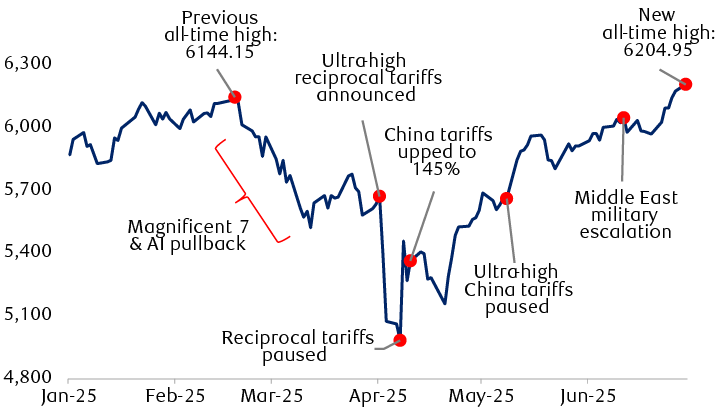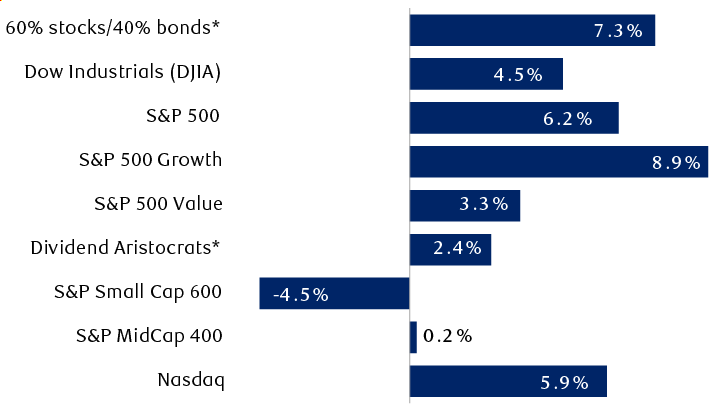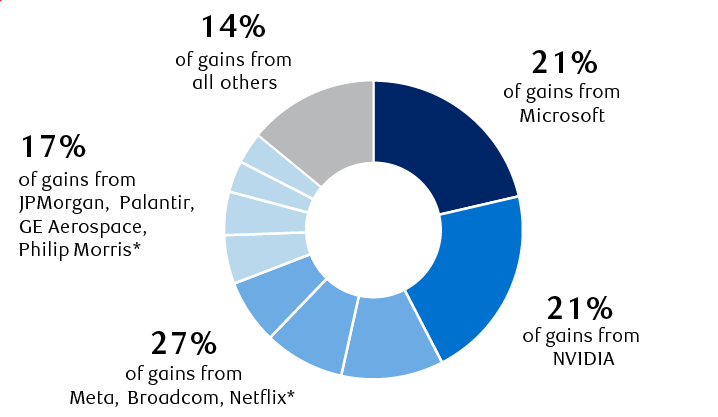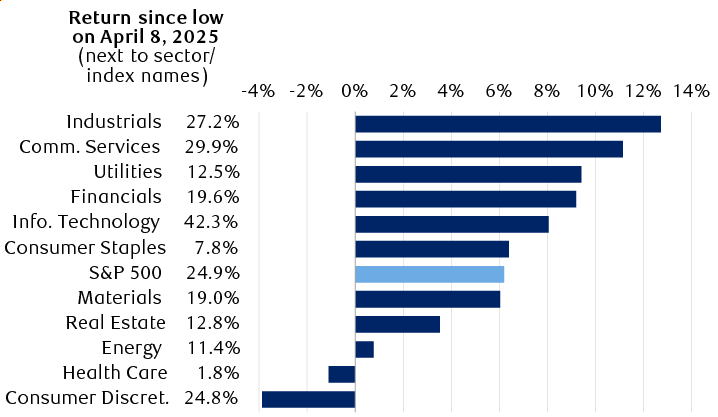The S&P 500 ended a volatile first half of the year up 5.5 percent (6.2 percent including dividends), defying doom and gloom sentiments, and climbing the proverbial wall of worry to new all-time highs in late June.
A casual observer looking at the U.S. stock market would be forgiven for believing that it was “business as usual” for corporate America. It was anything but.
On-off-on-off tariff policies
U.S. President Donald Trump’s tariff policies dominated market trends, generating significant downside and upside volatility in the spring.
Investor sentiment shifted to unease as Trump rolled out high tariffs on Canada and Mexico, and then turned deeply negative after the president imposed ultra-high so-called reciprocal tariffs on the rest of America’s trading partners on April 2 in the White House Rose Garden.
The S&P 500 tumbled 12.1 percent in just four trading sessions, and declined 18.9 percent from its peak level in February, nearly reaching the down 20 percent threshold that is widely accepted as bear market territory.
Following strong opposition from a motley crew of forces—including pushback from the U.S. Treasury bond market—the Trump team blinked. It paused the ultra-high reciprocal tariffs and, importantly, sent signals that sky-high tariff rates were unlikely to return on most trading partners.
The S&P 500 and Nasdaq Composite then surged 24.5 percent and 33.4 percent, respectively, off the April 8 bottom, and by the end of June each had climbed to new all-time highs.
As Trump’s “One Big Beautiful Bill Act”—his signature economic package—continued to work its way through Congress, the stock market was also boosted due to the legislation’s market-friendly tax and business provisions.
A new all-time high for the S&P 500 despite volatility

The S&P 500 Index began the year at 5868 and moved up to a new all-time high in of 6144 in mid-February. It then declined into March when Magnificent 7 and AI stocks pulled back, then bounced a little, and then lurched lower when ultra-high reciprocal tariffs were announced in early April. By April 8, the index had bottomed when reciprocal tariffs were paused. The market started to move up, but then China tariffs were raised to 145%, it sold off. But then it bounced in late April, and bounced more when ultra-high tariffs on China were paused in early May, and then the market pushed even higher through early June. It then paused briefly when Middle East military escalation occurred in mid-June. But soon thereafter it traded up to a new all-time high of almost 6205 on June 30.
Source - RBC Wealth Management, Bloomberg; daily data through 6/30/25
While we think the worst of Washington policy volatility has blown over the stock market, the tariffs already in place have the potential to generate economic headwinds and uncertainties.
RBC Global Asset Management estimates the U.S. average effective tariff rate will likely end up roughly around the 15 percent level when all is said and done, after agreements are finalized. This is the highest level since 1938 and is well above the 2.4 percent average in 2024.
We view tariffs as a tax, and at this stage it’s unclear who will foot the bill—foreign goods suppliers, domestic producers and services companies that use foreign goods as inputs, intermediaries and retailers, households, or some combination thereof.
Tame inflation (so far) with an eye toward rate cuts and earnings growth
While the stock and bond markets have been on inflation watch due to tariffs, both markets have rallied lately as inflation has yet to push higher. The U.S. Consumer Price Index drifted down from 2.9 percent in December 2024 to 2.4 percent by May, the most recent report.
The equity market looked past the 0.5 percent decline in Q1 GDP. This is largely because of tariff-related noise in the data and a snapback of some economic indicators in Q2.
Nevertheless, RBC Economics currently forecasts 1.6 percent GDP growth in 2025 and 1.3 percent in 2026, both subpar levels, but not recessionary.
If GDP growth ends up being below average like RBC expects, we think S&P 500 profit growth will be around mid-single-digit levels this year and next. That’s not bad and is no reason to become negative about the market’s prospects, but it’s below the 7.5 percent and 13.0 percent consensus earnings forecasts for each year, respectively.
The stock market also has been boosted by the likelihood that the U.S. Federal Reserve will resume rate cuts. The central bank is taking cues from the bond market, which is currently assuming two 25 basis point cuts later this year, the first one potentially coming in September.
Positive first-half returns for most indexes
First-half 2025 total returns of key indexes and styles (includes dividends)

The bar chart represents nine major U.S. indexes and styles showing performance for first-half 2025 based on total return data (includes dividends). 60% stocks/40% bonds +7.3%; Dow Jones Industrial Average +4.5%; S&P 500 +6.2%; S&P 500 Growth Index +8.9%; S&P 500 Value Index +3.3%; Dividend Growth (S&P 500 Dividend Aristocrats Index) +2.4%; S&P Small Cap 600 -4.5%; S&P MidCap 400 +0.2%; Nasdaq +5.9%.
* 60/40 portfolio based on the MSCI World Index and Bloomberg U.S. Aggregate Index. Dividend Aristocrats based on S&P 500 Dividend Aristocrats Index.
Source - RBC Wealth Management, Bloomberg; data range 12/31/24–6/30/25
DeepSeek splash and less uniform Magnificent 7 returns
Stocks leveraged to artificial intelligence (AI) technologies started the year wobbly as “show me the money” attitudes persisted around the return on capital from billions upon billions invested in AI. The unveiling of China’s DeepSeek AI chatbot app in late January also briefly jolted the U.S. AI industry. These stocks then pulled back due to earnings blemishes and nuances.
The combination of these factors is why the S&P 500 started its initial decline even before the ultra-high reciprocal tariffs were announced.
Since the April 8 market low, the performance of the AI-leveraged so-called Magnificent 7 stocks (Alphabet, Amazon.com, Apple, Meta Platforms, Microsoft, NVIDIA, and Tesla) has been less uniformly positive than in the past two years. During the first half of 2025, three of these stocks rose by double digits (Meta Platforms, Microsoft, and NVIDIA), whereas three declined (Tesla, Apple, and Alphabet, the first two by double digits), and Amazon.com was even.
When we dissect S&P 500 returns from the first half of 2025, it becomes obvious that the overall performance was mainly driven by just two stocks—AI-leveraged firms Microsoft and NVIDIA, which represented 42 percent of the index’s total return.
Nine stocks represented the bulk of market-cap-weighted gains
Percentage contribution to the S&P 500’s 6.2% total return in the first half of 2025

The pie chart shows the contribution to the S&P 500 total return in the first half of 2025. Microsoft and NVIDIA each contributed 21% of the gains. 27% of the gains were from three other stocks: Meta Platforms (11.07%), Broadcom (8.7%), and Netflix (6.98%). 17% of the gains were from four other stocks: JPMorgan Chase (5.28%), Palantir (4.71%), GE Aerospace (3.41%), and Philip Morris (3.4%). The other stocks in the index collectively represent 14% of the returns.
* Stocks listed from largest to smallest contribution.
Source - RBC Wealth Management, FactSet; total return data (includes dividends); data range 12/31/24–6/30/25
Add two other AI-leveraged firms, Meta Platforms and Broadcom, to this and 62 percent of the S&P 500’s total return was impacted by the emerging technology.
We could also make the case that shares of financial giant JPMorgan Chase and defense and security firm Palantir benefited from AI optimism, as both are viewed by Wall Street analysts as AI leaders in their respective industries.
In total, these six AI-leveraged stocks made up 79 percent of the S&P 500’s total return during the first half of 2025.
Admittedly, this statistic is eye-popping, but investors should keep in mind that the construction of the S&P 500 is one of the main reasons.
Stocks with a large market capitalization (total value of all shares) have higher representation within the index by design. Five of the six stocks above are “mega-cap” stocks, meaning their capitalizations are much greater than the average S&P 500 stock.
When mega-cap stocks do well (or conversely, when they do poorly), they have an outsized impact on the S&P 500’s return.
This phenomenon is also illustrated in the poorly performing category of first-half 2025 returns. Apple, Tesla, UnitedHealth, and Alphabet were the four biggest detractors from S&P 500 performance due to the combination of their declines (the first three dropped by double digits) and mega/large-cap status.
Leadership broader than it looks at first blush
Digging further into first-half 2025 returns, leadership within the S&P 500 wasn’t as narrow as it might seem when the market-cap issue is set aside.
- Nine of 11 sectors rose during the period, and six outperformed the S&P 500
- 19 of 25 major industry groups (a level below sectors) rallied
- 60 percent of S&P 500 stocks rose
- The median and average S&P 500 stock gains were 3.9 percent and 4.7 percent, respectively, including dividends
- The S&P 500 Equal Weight Index rallied 4.8 percent, including dividends
We think this is a more useful way to assess returns when comparing portfolios that include individual U.S. equities.
All but two sectors rose in the first half of 2025
S&P 500 and sector total returns (including dividends)

The bar chart shows S&P 500 and sector total returns in two ways: Return in the first half of 2025, and since the April 8, 2025 low. All data include dividends. The returns are as follows in this order: Return in first-half 2025 and since April 8 low. S&P 500 +6.2%, +24.9%. Industrials +12.7%, +27.2%. Communication Services +11.1%, +29.9%. Utilities +9.4%, +12.5%. Financials +19.6%, +30.5%. Information Technology +8.1%, +42.3%. Consumer Staples +6.4%, +7.8%. Materials +6.0%, +19.0%. Real Estate +3.5%, +12.8%. Energy +0.8%, +11.4%. Health Care -1.1%, +1.8%. Consumer Discretionary -3.9%, +24.8%.
Source - RBC Wealth Management, Bloomberg; data range 12/31/24–6/30/25
Shift in focus
While the tariff saga has not yet been fully resolved and more news is likely in July and possibly later, we think much of the drama associated with Washington policies is in the rearview mirror.
The market’s attention in the second half of 2025 and 2026 will likely be on the impacts of tariffs already in place and the “Big Beautiful Bill” on the economy and corporate earnings.
For additional thoughts about the second half and recommendations for portfolio positioning, see our complete Global Insight 2025 Midyear Outlook or the individual articles.

